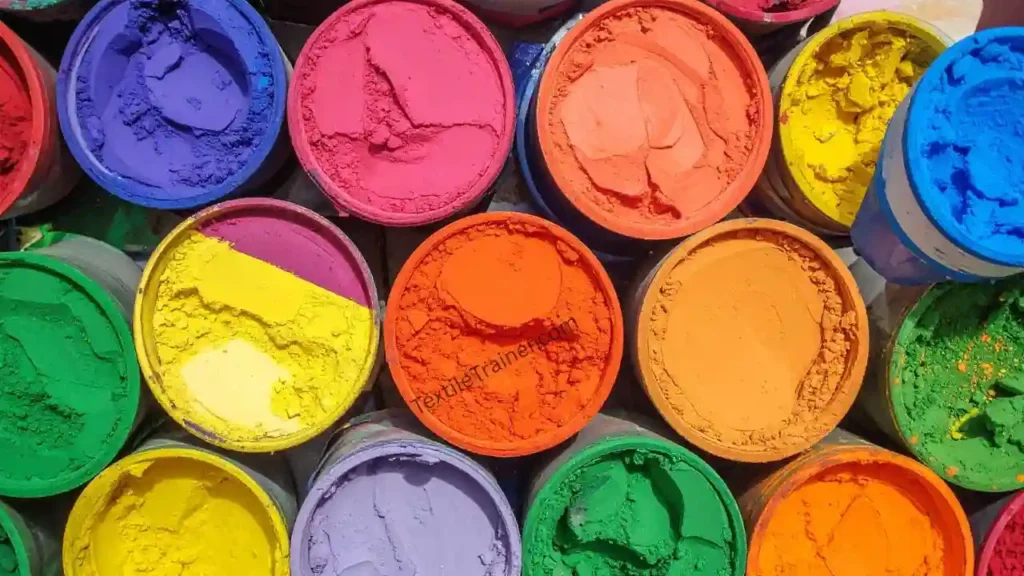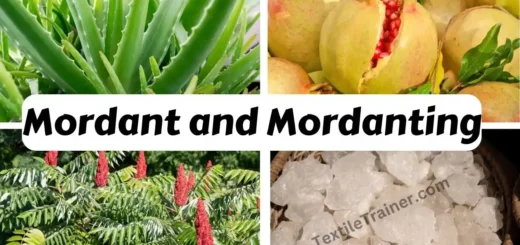Cotton Pigment Dyeing Process: Explained in 3 Easy Steps
Introduction
Pigments are not dyes. It is an organic or inorganic coloring substance that has no affinity to fibers. This article is about the cotton pigment dyeing process. Unlike reactive or direct dyes, pigments are insoluble color particles. As it has no affinity to fiber, a binder is required to fix them onto the fiber surface. However, pigments are widely used in the fashion world owing to their wide color range as well as fast processing. Pigment dyeing is a versatile and cost-effective method. This article will guide the cotton pigment dyeing process, its advantages and disadvantages, including a typical recipe of the cotton pigment dyeing process and recipe calculation.
What is pigment dyeing?
Pigment is a insoluble color substance which is applied on cotton by using binder. According to the definition proposed by Colored Pigments Manufacturers Association (CPMA)-“Pigments are colored, black, white or fluorescent particulate organic or inorganic solids which usually are practically insoluble in the application medium and are used to impart color or other functional properties to a substrate”.

Properties of pigments
Pigments are insoluble coloring materials. It provides color and functional effects to textile fabrics. In textile dyeing, pigments are fixed onto the fiber surface by using a binder. Because, it cannot penetrate in fiber or chemically react with fibers. However, below are the key properties of pigments:
- Pigments are completely insoluble in water as well as all application media.
- It has high tinting strength.
- The average particle size of pigments ranges between 0.01 to 1 micron. Smaller particles provide brighter shades and vice versa.
- Pigments show excellent to good light-fastness and wash fastness properties. But, rubbing fastness of pigment dyeing is good to poor. (Overall fastness properties depends on binder properties and curing process)
- Additionally, it has high heat resistance.
Trade name of pigment
| Brand name | Company name | Country name |
| Microfix dyes | Ciba-Geigy | Switzerland |
| Impersion dyes | Hoechst | Germany |
| Acramine dyes | Bayer | W. Germany |
| Helizarine Dyes | BASF | W. Germany |
| Printofix dyes | Sandoz | Switzerland |
| Tinilita | Ciba-Geigy | Switzerland |
Cotton Pigment Dyeing Process
There are 3 steps for the cotton pigment dyeing process:
- Step-1: Cationizing
- Step-2: Pigmentation
- Step-3: Aftertreatment
Step-1: Cationizing
Typical recipe for cationizing process-
| Chemicals | Amount (gm/l) |
| Cationizing agent | 4.0-8.0 |
| Acetic acid | 0.5-1.0 |
| Temperature | 40-500 C |
| Time | 20-30 min |
| pH | 4.5-5.5 |
| M:L | 1:20 |
| Cotton fabric weight | 5 gm |
Recipe calculation for cotton pigment dyeing process is below. For dyeing recipe calculation following two formulas is used.
- Required auxiliary= (Total amount of liquor× recipe amount) ÷ (1000× stock solution)
- Required dyestuff= (Fabric weight × Shade percentage) ÷ Stock solution
Now, Let’s calculate the dyeing recipe for cotton pigment dyeing process.
- Total amount of liquor required for cotton pigment dyeing process= 5×20= 100 ml
- Cationizing agent required= {total amount of liquor× recipe amount (gm/l)} ÷ (1000×stock solution) = (100×8) ÷ (1000× 2%) = 40 ml [ use 2% stock solution]
- Acetic required= (100×1) ÷ (1000× 2%) = 5 ml [ use 2% stock solution]
- Required water= {100- (40+5)}= 55 ml
Now, learn about the cationizing process:
- Initially, add water, cationizing agent, and fabric according to the recipe calculation.
- Now, run the min for 5-10 min and add the acetic acid to maintain a slightly acidic. Then, check the pH (4.5-5.5).
- Subsequently, run the bath for 20-30 min at 40-500 C.
- Finally, drop the bath and rinse the sample with hot and cold water, respectively.
Step-2: Pigmentation
Typical recipe for cotton pigmentation
| Chemicals | Amount |
| Pigment | 2% (OWF) |
| Acetic acid | 0.5-1.0 gm/l |
| Temperature | 60-700 C |
| Time | 15-30 min |
| pH | 4-5 |
| M:L | 1:20 |
| Fabric weight | 5 gm |
Procedure-
- Set the dye bath with cationized cotton fabric at room temperature
- Now, Run the machine for 5 min and add pigment in dye bath. Then run the machine for 5-10 minutes again.
- Next step, rise the temperature to 700 C for 10 min.
- After 10 min, add acetic acid and check the pH value.
- Then, run the machine for 10 min at 700 C again.
- Finally, rinse the sample.
Step-3: Aftertreatment
For fixing the pigment with fiber, fabric must treat with the following recipe.
| Chemical | Amount |
| Acrylic binder | 3.0-5.0% (OWF) |
| Acetic acid | 0.5-1.0 gm/l |
| Cationic softener | 1.0-3.0% (OWF) |
| Temperature | 50-600 C |
| Time | 10-15 min |
| pH | 4-5 |
| M:L | 1:20 |
| Then rinse the sample to remove unfixed pigment and other unexpected chemicals. | |
Advantages of Pigment Dyeing
- Pigment works on almost any fiber type.
- It has bright shades and wide color range.
- It has excellent to good fastness properties (wash and light).
- Pigment has no fiber-specific chemical reaction required.
Disadvantages of Pigment
- Binder can affect fabric hand feel.
- In cotton pigment dyeing process needs curing equipment.
- Pigment dyeing process is not suitable for deep shades without multiple applications.
- Rubbing fastness property is poor.
FAQ: Cotton Pigment Dyeing
- What is the difference between pigment and reactive dyes?
- Pigment is an insoluble particle fixed with a binder. On the other hand, reactive dye chemically bonds to cotton fiber.
- Why is a binder necessary in cotton pigment dyeing?
- Pigment is insoluble dye and has no affinity to fiber. Hence, the binder adheres the pigment particles to the cotton fiber surface. So, it is necessary to use binder to fixed the pigment with cotton fiber.
- How to improve fastness in pigment dyeing?
- Fastness properties of pigment can be improved by using high quality binder and proper curing temperature and time.
- Can pigment dyeing be done on polyester?
- Yes, pigment is suitable for synthetic fiber as well as polyester. But suitable binder is need. Additionally, curing conditions may differ.
Conclusion
This is the totally cotton pigment dyeing process. This article tried to give a minimum idea about the cotton pigment dyeing process. Basically, pigment is used for printing. However, if you have any questions about the pigment dyeing process, let me know in the comment box.
You May Read:



